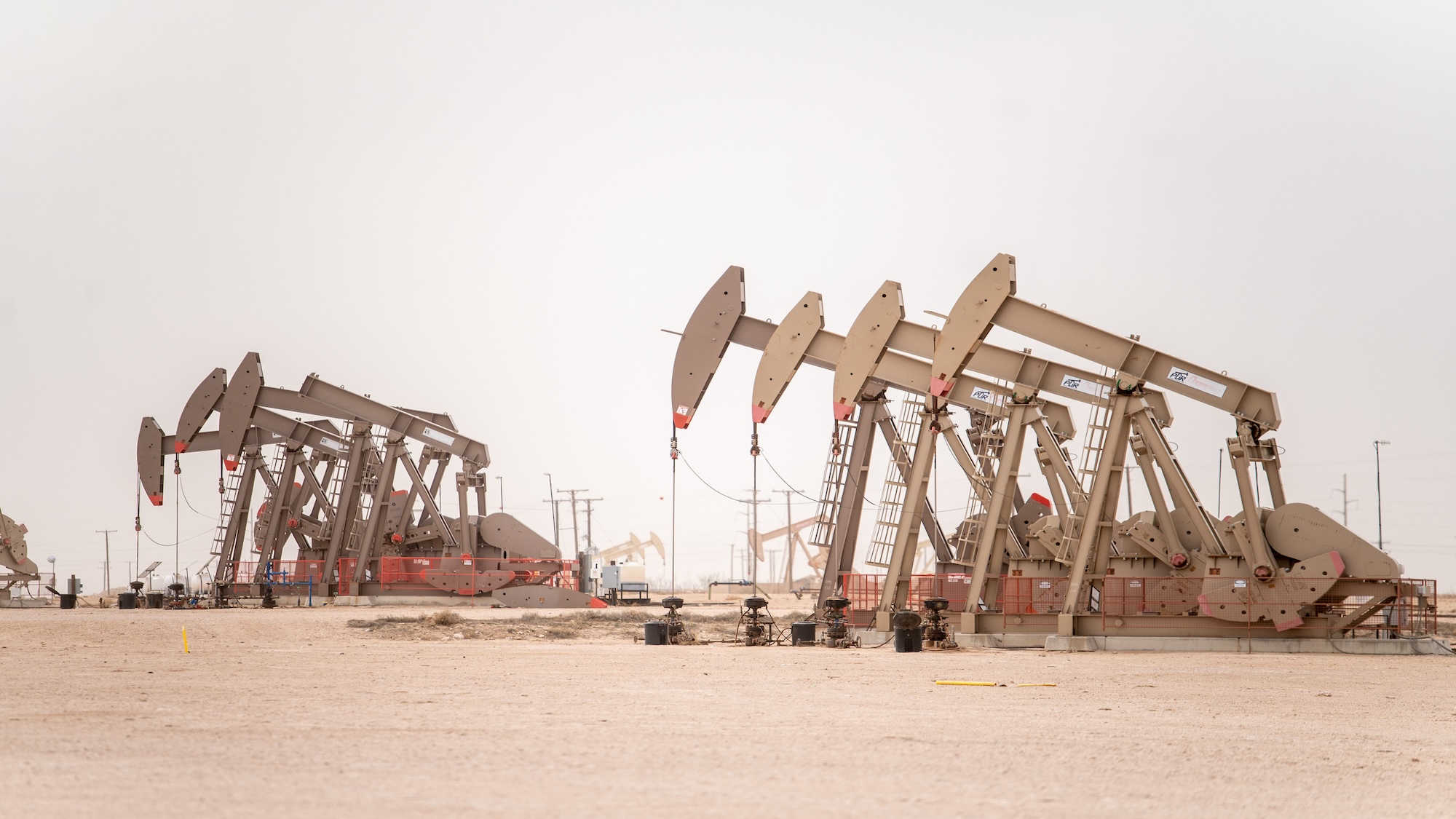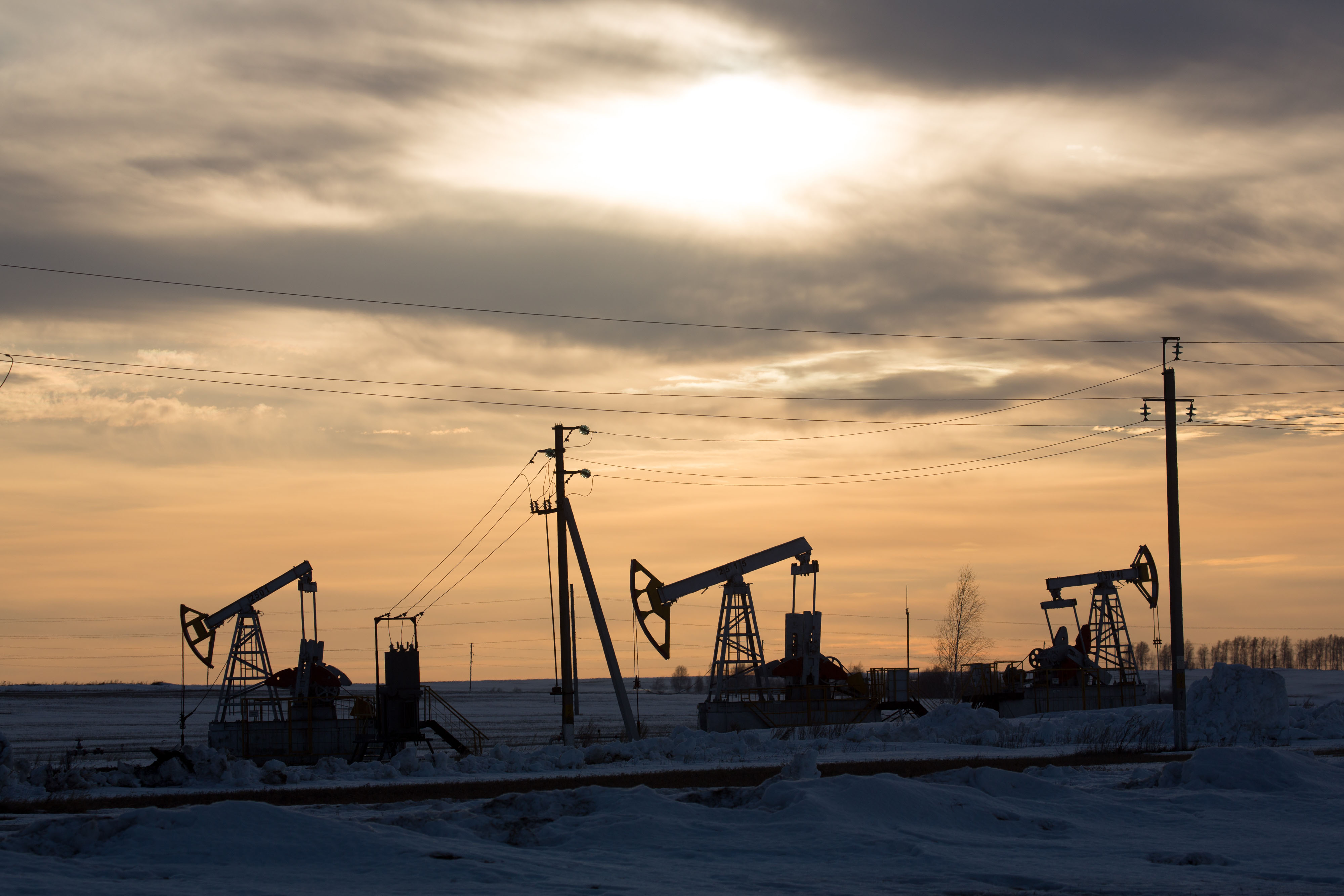Oil price posts two-year highs - but how long can it last?
Brent rose above $59 a barrel this week, its best third-quarter showing since 2004

Oil price rally becomes 'double-edged sword'
21 March
The oil price has fallen from its latest 2016 high after signs that a rebalancing of the market is already being compromised – by the rally caused by the rebalancing.
In short: tentative action to reverse the supply glut has driven a strong price upswing in recent weeks, but the higher price is encouraging struggling producers to pump more oil to boost profits.
The Week
Escape your echo chamber. Get the facts behind the news, plus analysis from multiple perspectives.

Sign up for The Week's Free Newsletters
From our morning news briefing to a weekly Good News Newsletter, get the best of The Week delivered directly to your inbox.
From our morning news briefing to a weekly Good News Newsletter, get the best of The Week delivered directly to your inbox.
"The drop in production will halt... It's a bit of a double-edged sword," says James Burgess on Oilprice.com.
Specific data causing the concern came on Friday, when, City AM reports, news broke that the rig count of the number of active drilling wells in the US rose in February, the first time in six months. This defies those who expect US shale production to wither consistently this year and potentially vindicates those who warned higher prices would bring nimble US production back to the market.
Last week, international benchmark Brent crude rose comfortably above $42 a barrel as the US Energy Information Administration showed US oil output had dipped closer to nine million barrels a day – and could fall to 8.6 million by the end of this year and 8.2 million by the end of 2017.
That also came on the back of confirmation that around three-quarters of global producers from both in- and outside of the Opec cartel would meet next month to discuss a freeze to supply at January levels. But Panos Mourdoukoutas writes on Forbes that even this underwhelming agreement might be in doubt if US exports are ramped up.
A free daily email with the biggest news stories of the day – and the best features from TheWeek.com
He says that at around $40 a barrel, a lot of US shale production breaks even and that is why supply may be coming back on line. So, Saudi Arabia, one of the largest producers in the world and the de facto leader of Opec, may opt to push its own production higher to drive prices back down, as it can break even with prices much lower at as low as $20 a barrel.
"Saudi Arabia faces a stark choice: either let markets crush American frackers or watch American frackers crush markets," Mourdoukoutas says.
Brent crude fell one per cent on Friday and was down again this morning, hitting as low as $40.70 a barrel.
Can the oil price recovery be maintained?
18 March
The oil price is back into the swing of a rally that has been gathering momentum for the past month and set another high for the year so far.
International benchmark Brent crude rose another two per cent yesterday, building on gains of four per cent the day before, as growing optimism over a possible supply deal fuelled a surge to $41.60 a barrel. Its US counterpart also consolidated above $40 and reached its own 2016 peak at $40.55 a barrel.
Oil producers have agreed to meet in Doha, Qatar, in around a month's time to discuss a freeze in production at January levels. Around 15 suppliers making up close to three-quarters of global output are signed up to the initiative.
There's also the supportive monetary policy framework and a dovish signal from the Federal Reserve on Wednesday, which left the dollar at five-month lows and makes oil cheaper for overseas buyers.
But the question is: can the recovery hold and will prices go on to rally further and once again begin delivering profits for producers? Many analysts think so, believing that the low of $27 a barrel for Brent reached on 11 February established a firm bottom for the market.
"Traders do seem to be looking through the current high inventory levels and prices just keep marching higher," Martin King, a commodity analyst with Calgary-based FirstEnergy Capital, told the Edmonton Journal. He says prices may not hold at current highs in the short-term, but that they will not now go lower than $30 a barrel and will move up over the next year or so.
"On a 12 to 18-month view, oil prices should normalise back to the marginal cost of supply of at least $60," agreed Michael Hulme, a fund manager at Carmignac Gestion, the French investment group, in comments to The Times.
But not everyone is convinced. Oil stockpiles are at record highs and a deal to freeze supplies would only entrench, for the time being at least, excess exports of one to two million barrels a day.
"Global fundamentals are little changed and oil has instead been lifted by higher risk-appetite," BNP Paribas said in a note reported by Reuters. "A dialogue among key producing countries to address oil output will at best yield a decision to freeze output, but not the much-needed reduction required to rebalance the market."
"I think the rally is misguided," John Brynjolfsson, a co-manager of the James Alpha Global Enhanced Real Return fund, warned the Wall Street Journal. "I don't think that amount of oil sloshing around with literally no place to go is going to sustain oil prices."
Oil price soars back to form after triple-whammy boost
17 March
The oil price ended a two-day slide yesterday and hit a new 2016 high this morning, after a triple-whammy boost from the UK Budget, the US Federal Reserve and fresh optimism on a supply deal.
First came the news from George Osborne that the UK is easing taxes on the North Sea industry to help producers. "The chancellor halved a supplementary charge levied on offshore fields and completely abolished a 30 per cent petroleum revenue tax," says The Guardian.
Pros and cons: Should Britain vote Leave or Remain?
Polling data: Which side will win?
The move, which should ease pressure on companies active in the UK offshore oil sector, will result in the industry costing the UK taxpayer £1bn each year from 2016-17.
Next up came the US Federal Reserve, which announced its latest monetary policy decision that revealed it expects a much shallower path of increasing interest rates this year. This hit the dollar, which makes commodities denominated in the currency expensive and is seen as supportive of global demand, notes Reuters.
Finally - and most importantly - there was fresh news on a meeting next month aimed at finalising the deal to freeze global oil supplies at January levels. Qatari minister Mohammed bin Saleh al-Sada said the initiative now had the support of 15 OPEC and non-OPEC producers, accounting for about 73 per cent of international output.
The Wall Street Journal adds that it now looks likely talks will go ahead and a deal be signed even without the presence of Iran, which has said it will only consider capping exports once it returns to a pre-sanctions level of four million barrels a day.
After all that, international benchmark Brent crude, which sets prices for oil extracted in regions including the North Sea, rose more than five per cent from its starting point yesterday and was at $41.40 this morning, a new high for the year. US prices rose six per cent, even despite a fifth straight week when the country's crude reserves hit an all-time record.
But the fact that domestic oil stockpiles in the US and around the world are at record highs continues to weigh on sentiment, as analysts warn the proposed freeze will only entrench current excess production.
Societe Generale has lowered its oil price forecast again, while US Bank Wealth Management agreed "oil prices will remain relatively low for some time".
Oil price rally 'being driven by speculators'
16 March
The oil price rally remains well above the lows it had hit early last month, but analysts warn prices remain low and vulnerable to another sudden downward shift.
International benchmark Brent crude had risen around 50 per cent from its nadir of $27 on 11 February to more than $41 last week, but after a couple of consecutive negative sessions, it was down below $39 yesterday. It has since edged slightly higher and was moving modestly positively in morning trading today, reaching around $39.40 by 10am.
The mild upswing was caused in part by a better-than-expected report from the American Petroleum Institute, which Reuters notes estimated a 1.5 million barrel build in US crude stockpiles last week, compared to predictions of a rise above three million. There was also a modest drop in gasoline reserves, although less than expected.
Meanwhile, Reuters reports that the powerful Opec cartel has said it will meet next month to discuss a price freeze without Iran, , which has so far refused to join the deal backed by Saudi Arabia and Russia.
However, none of this points to a rebalancing of the oversupplied market anytime soon, some analysts say. Nick Cunningham notes on Oilprice.com that US stockpiles are at all-time highs and that the OECD believes global reserves will rise from last year's three billion barrels to 3.24 billion in 2016 and then on to 3.3 billion barrels by the end of 2017.
Given that US production is proving stubbornly resilient, Saudi Arabia and Russia are pledging only to limit pumping to near record highs above ten million barrels a day and Iran is planning a four-fold increase on January's one million barrels a day, the glut is a long way from done. And that means prices are susceptible to turning once sentiment shifts again.
In fact, Cunningham argues, "there is evidence that suggests the rally was driven by speculators closing out short bets on oil". By this he means that as prices turned positive, speculators had to rush to cover negative bets on future prices, fuelling a rally that has become temporarily self-sustaining.
That will not last unless there is more fundamental move on supplies that begins to eat into the massive overhang, he says.
Oil price: 'We're likely to see $35 a barrel before we see $45'
15 March
A proposal to freeze crude oil supplies at January levels looks increasingly unlikely to rebalance an oversupplied market, meaning prices may retreat further following a prolonged rally.
International benchmark Brent crude hit $41 last week, a rise of as much as 50 per cent from its 11 February low of $27 a barrel. But the price fell close to three per cent yesterday and it was down another two per cent this morning, to $38.70.
This slip was caused in part by a bearish outlook from the powerful 13-nation Opec cartel, which predicted demand would be lower this year than expected and said production was holding at levels that exceed the amount of oil it is selling.
Demand would average 31.52 million barrels per day in 2016, added the organisation, which Reuters notes is down 90,000 from last month's forecast. The countries collectively pumped 32.28 million barrels per day in February - and even this was down 175,000 from January, due to temporary pipeline problems in Iraq and Nigeria.
A contributing factor to the Opec supply excess is the ramping up of exports from Iran since it emerged from international sanctions in January. Reuters analysts reckon supply has risen from one million to more than three million barrels a day, with the BBC reporting comments from the country's oil minister saying it will not discuss any deals until it has matched its pre-sanctions level of four million.
All in all, it is clear that oversupply currently running at one to two million barrels a day is not going to be simply cleared up by the tentative agreement to freeze output, while the Iranian intransigence undermines the chances of this deal holding in any case. Analysts are therefore pessimistic the recent oil price rally will hold.
"We are likely to see $35 a barrel before we see $45 a barrel," Bjarne Schieldrop, the chief commodities analyst at SEB Markets in Oslo, said.
Emphasising the ongoing glut, analysts have predicted that US domestic crude inventories will have risen by 3.3 million barrels when new weekly data is published this week. Shale oil production in particular has proven much more resilient to the price fall than many had expected and US output is still running at more than nine million barrels a day.
-
 Received a gift card this holiday season? Here’s how to maximize it.
Received a gift card this holiday season? Here’s how to maximize it.The Explainer Make the most of your present
-
 ‘Lumpy skin’ protests intensify across France as farmers fight cull
‘Lumpy skin’ protests intensify across France as farmers fight cullIN THE SPOTLIGHT A bovine outbreak coupled with ongoing governmental frustrations is causing major problems for French civil society
-
 The best books of 2025
The best books of 2025The Week Recommends A deep dive into the site of a mass shooting, a new release from the author of ‘Atonement’ and more
-
 How might the Israel-Hamas war affect the global economy?
How might the Israel-Hamas war affect the global economy?Today's Big Question Regional escalation could send oil prices and inflation sky-high, sparking a worldwide recession
-
 Recent mega-mergers could signal a turning point for the US oil industry
Recent mega-mergers could signal a turning point for the US oil industryTalking Point Both Chevron and Exxon have recently spent billions to acquire smaller oil companies
-
 Has Saudi Arabia lost control of oil prices?
Has Saudi Arabia lost control of oil prices?Today's Big Question Kingdom goes it alone to cut production, risking tension with US and reigniting cooling inflation in Europe
-
 US angered by Opec+ oil cut
US angered by Opec+ oil cutSpeed Read Energy prices to rise further as producers slash supply by two million barrels a day
-
 Global oil demand forecast lowered for 2020 and 2021
Global oil demand forecast lowered for 2020 and 2021Speed Read IEA report says jet fuel demand remains the major source of weakness
-
 Are US-Iran tensions flaring again?
Are US-Iran tensions flaring again?In Depth Trump threatens military action over Twitter
-
 Can a deal be struck to raise oil prices?
Can a deal be struck to raise oil prices?In Depth Opec+ will convene today over video link in a bid to boost crude
-
 What do negative oil prices mean?
What do negative oil prices mean?In Depth Perfect storm of oversupply and storage shortages sees producers paying to get rid of US crude
